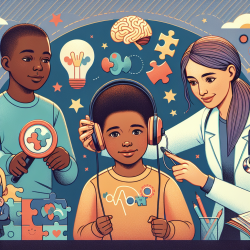The recent research article, "Perspective on Clinical High-Risk for Psychosis in Africa," offers critical insights that can significantly enhance the skills of practitioners, particularly those working with children. As we strive for better outcomes for our young clients, understanding the nuances of psychosis risk and early intervention strategies is paramount. This blog will distill key findings from the research and provide actionable steps for practitioners to implement in their practice.
Understanding Clinical High-Risk for Psychosis (CHR-P)
Psychosis encompasses conditions like schizophrenia and mood disorders with psychosis, characterized by delusions, hallucinations, and disorganized thought and behavior. The CHR-P state is a pre-psychotic phase marked by subclinical symptoms such as cognitive decline and functional impairment. Identifying and intervening during this stage can prevent or delay the onset of full-blown psychosis.
Key Findings from the Research
The study highlights several important aspects:
- Prevalence: Psychosis-risk symptoms are relatively common in African populations, with varying prevalence rates reported in different studies.
- Risk Factors: Childhood adversity, stress sensitivity, bullying, psychiatric comorbidities, and neurocognitive deficits are significant risk factors for CHR-P.
- Predictors of Conversion: Disorganized communication is a strong predictor of transition to psychosis.
- Sociocultural Factors: Stigma and barriers to accessing mental health care are prevalent, hindering early intervention efforts.
Actionable Steps for Practitioners
Based on the research findings, here are several steps practitioners can take to improve their skills and outcomes for children at risk:
1. Early Identification and Assessment
- Utilize validated screening tools like the Prodromal Questionnaire (PQ-B) and the Comprehensive Assessment of At-Risk Mental States (CAARMS) to identify children at risk.
- Be vigilant for signs of disorganized communication, which can be a predictor of psychosis conversion.
2. Addressing Risk Factors
- Provide trauma-informed care to address the neurodevelopmental effects of childhood adversity.
- Implement stress management programs, particularly for adolescents who face school-related and peer-related stressors.
- Conduct comprehensive assessments for psychiatric comorbidities and neurocognitive deficits.
3. Overcoming Sociocultural Barriers
- Engage in community education to reduce stigma and improve mental health literacy.
- Collaborate with traditional healers and community leaders to create culturally sensitive interventions.
4. Implementing Early Intervention Strategies
- Offer evidence-based interventions like cognitive-behavioral therapy, family support, and psychoeducation.
- Explore pharmacological options and nutritional supplements as part of a comprehensive treatment plan.
Encouraging Further Research
While the research provides valuable insights, there is a need for more longitudinal studies to understand the progression of CHR-P in African settings better. Practitioners are encouraged to participate in or support research efforts that aim to develop culturally valid assessment tools and intervention strategies.To read the original research paper, please follow this link:
Perspective on Clinical High-Risk for Psychosis in Africa.










